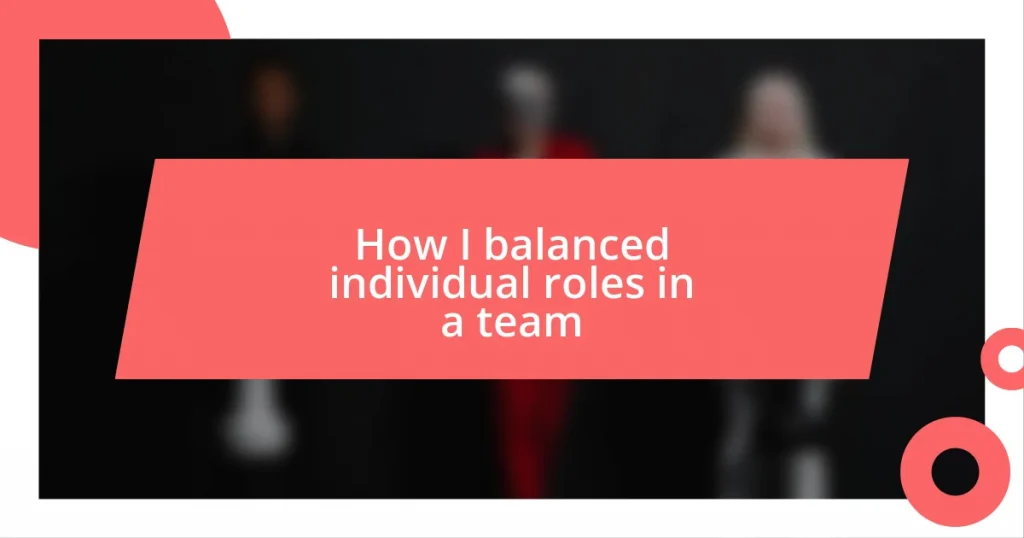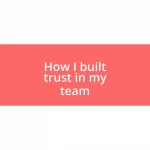Key takeaways:
- Cultivating role clarity within a team enhances collaboration and success by ensuring that each member embraces their strengths.
- Effective communication fosters a safe environment where team members can express ideas and concerns, leading to deeper engagement and innovation.
- Practicing empathy and addressing individual challenges promotes trust and strengthens team dynamics, transforming conflicts into growth opportunities.
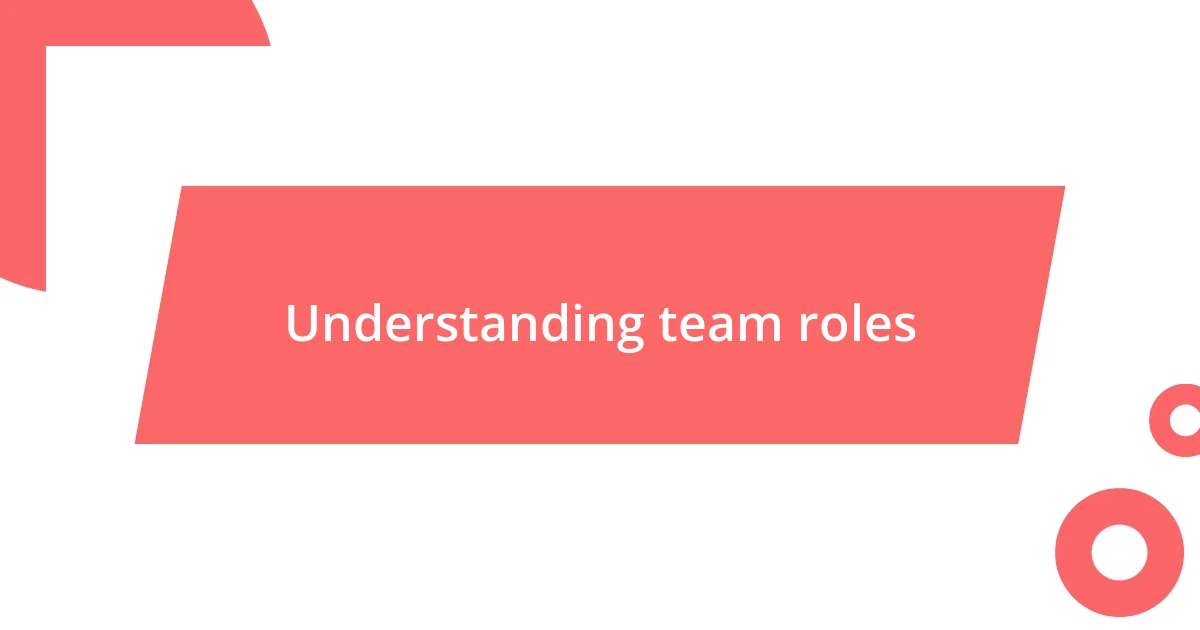
Understanding team roles
Understanding the different roles within a team is crucial for fostering collaboration and achieving success. I remember a project where we had a defined leader, a creative thinker, and meticulous organizers. Each of these roles brought a unique strength, and seeing how they interacted made me realize that success doesn’t just depend on individual talent; it thrives on how well those talents complement one another.
Have you ever found yourself wondering why some teams gel effortlessly while others struggle? From my experience, it often comes down to role clarity. In one memorable project, we initially faced chaos. Once we defined everyone’s strengths—who would strategize, who would execute, and who would oversee quality—everything fell into place. It made me appreciate how vital it is for team members to not just occupy a role but to truly embrace it.
On another occasion, I served as the communicator in a group that lacked direction. I had to step up, not just to share information but to foster an environment where everyone felt safe contributing ideas. That experience taught me that a role is more than a title; it’s about creating connections, trust, and the spirit of teamwork. How can you ensure that your role supports the team dynamic effectively? It’s definitely a thought worth exploring.
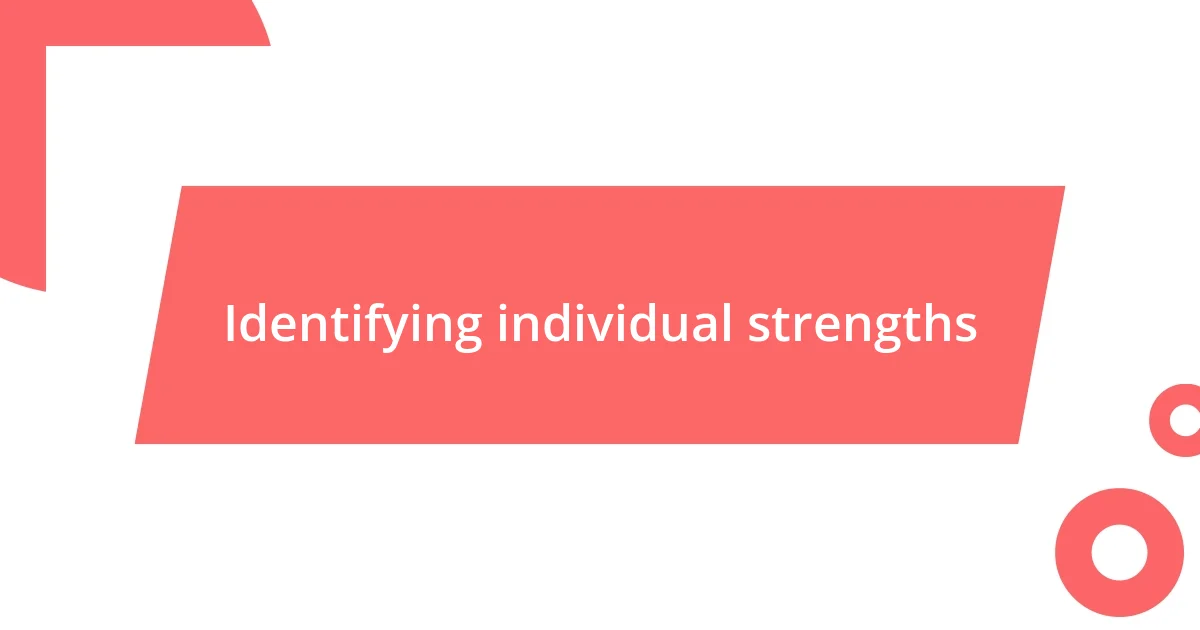
Identifying individual strengths
When it comes to identifying individual strengths, I can’t emphasize enough how important it is to observe team members closely. In one of my previous projects, I noticed that one colleague was exceptionally good at data analysis while another had a knack for creative problem-solving. By recognizing these unique talents, I was able to suggest roles that played to their strengths, which boosted their confidence and our overall productivity. It’s fascinating how acknowledging someone’s true capabilities can not only enhance their performance but also uplift the entire team.
I’ve also experienced situations where members weren’t aware of their strengths. In one particular case, we conducted a fun exercise where each person shared what they thought they excelled at and explored feedback from colleagues. This reflection led to surprising discoveries; for instance, a quiet member of the team revealed a talent for visual presentations that we hadn’t tapped into before. Emphasizing personal strengths fosters a supportive culture where everyone feels valued and motivated to contribute. It’s quite amazing to witness the transformation when people realize the unique value they bring.
In my experience, tools like personality assessments can be incredibly helpful for uncovering individual strengths. When I introduced these to my teams, it sparked insightful conversations. For example, knowing that someone is a ‘Navigator’ by nature—good at strategic planning—helped us direct tasks more appropriately. How often do we overlook the potential of those around us because we haven’t taken the time to dig deeper?
| Strengths Identification Method | Description |
|---|---|
| Observation | Careful watching and noting individual contributions over time. |
| Peer Feedback | Encouraging team members to share their views on each other’s strengths. |
| Personality Assessments | Using tools to understand and categorize individual traits. |
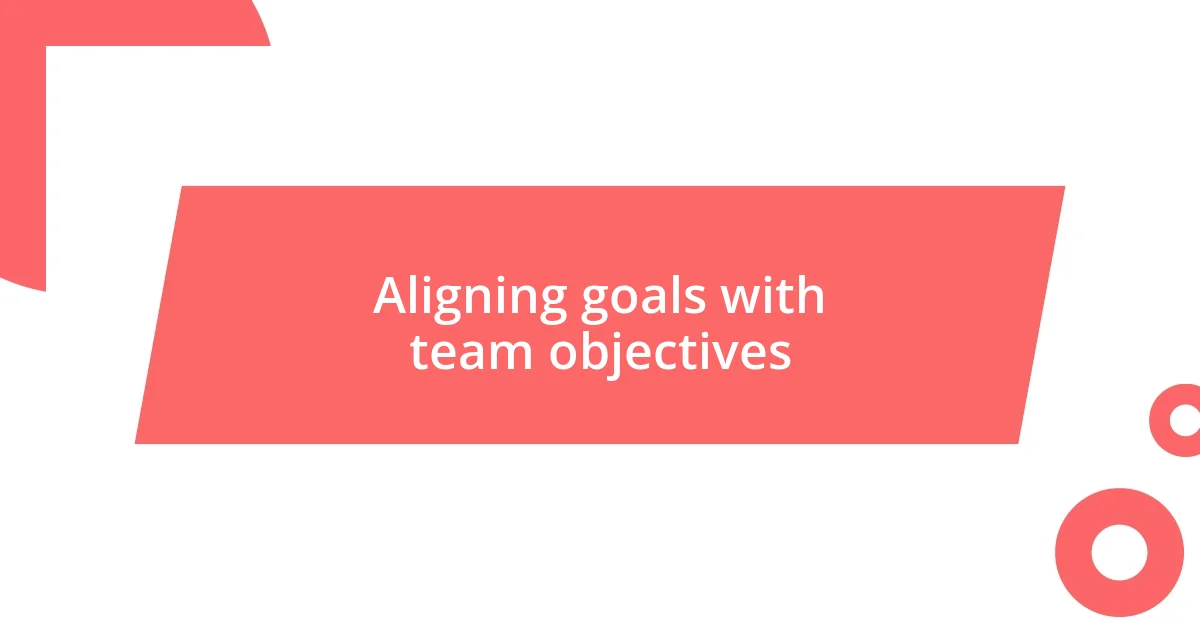
Aligning goals with team objectives
Aligning individual goals with team objectives can be a game-changer. I’ve found that when team members deeply understand both their personal aspirations and the team’s direction, they feel more engaged and driven. In one project, I recall an instance where I shared my personal goal of improving my leadership skills, and this openness led to others expressing their ambitions as well. This collective sharing cultivated a sense of shared purpose and camaraderie that significantly boosted our motivation.
- Clearly communicate the team’s objectives to ensure everyone is on the same page.
- Encourage discussions about personal goals during team meetings to foster transparency.
- Regularly revisit and adjust individual tasks to align with overarching goals, maintaining motivation and relevance.
Often, it requires a gentle nudge or facilitation to bridge the gap between personal and team ambitions. I remember guiding a shy team member who wanted to develop her project management skills. By aligning her tasks with the team’s timelines, she gradually grew more confident. Witnessing her transformation was incredibly rewarding, and it reaffirmed my belief that when aspirations are in sync, everyone thrives.
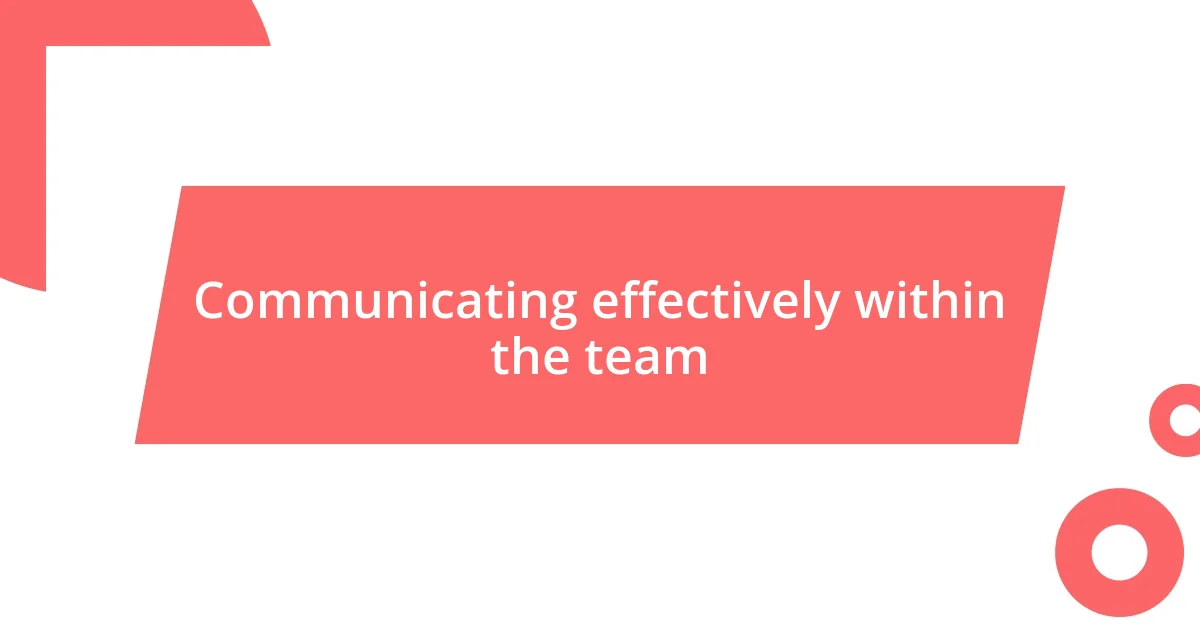
Communicating effectively within the team
Effective communication within a team isn’t just about sharing information; it’s about creating connections. I remember a time when we faced a crucial deadline, and it felt like everyone was under immense pressure. I decided to initiate daily brief huddles, giving everyone a quick chance to share what they were working on. The shift was remarkable. It wasn’t just about updates; those moments fostered a sense of solidarity, encouraging team members to support each other in real-time. Have you ever witnessed how a small change in communication can transform the atmosphere?
One aspect of effective communication is ensuring everyone feels comfortable voicing their ideas and concerns. In one project, I noticed a talented team member often held back during meetings. I reached out and encouraged her to share her thoughts, emphasizing that we’ve all faced challenges in expressing ourselves. Gradually, her insights became invaluable, enriching our discussions. It’s a simple reminder that creating a safe space to communicate can unlock incredible potential within the team.
I’ve learned that active listening plays a crucial role in how teams communicate. During brainstorming sessions, I make it a point to paraphrase and reflect back what teammates say. For example, after one of my colleagues presented a bold idea, I responded with, “So, what I hear you saying is…” This not only shows that I value their input but also invites others to delve deeper into the conversation. Have you ever engaged in a discussion where you felt genuinely heard? That’s the kind of environment I strive to create—one where every voice is acknowledged and valued.
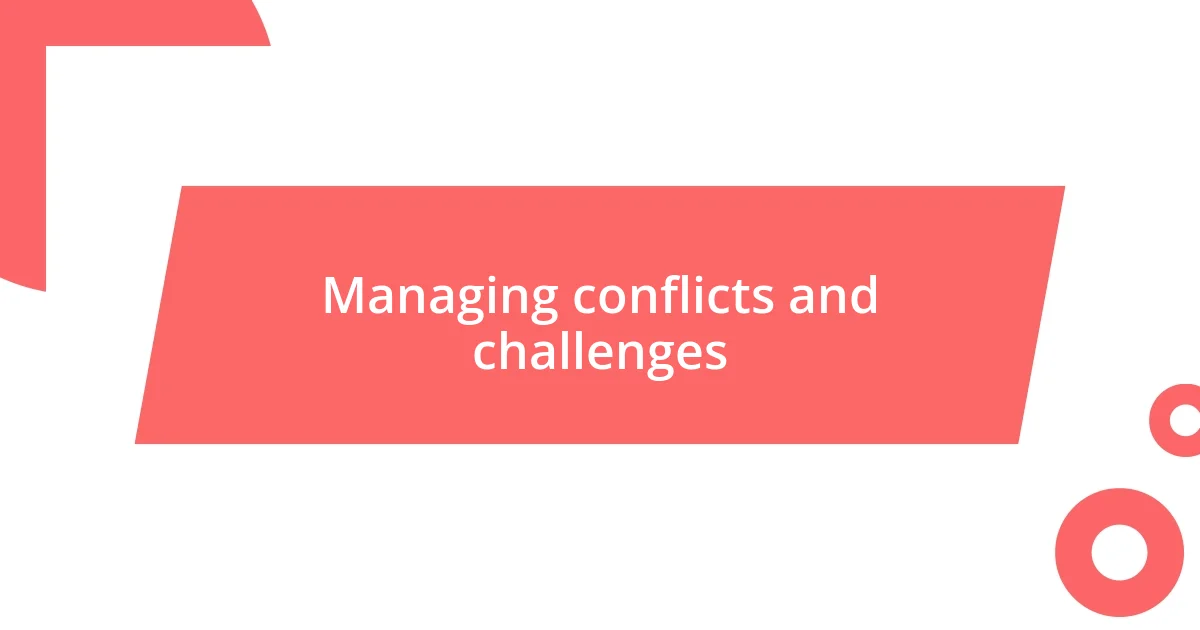
Managing conflicts and challenges
Managing conflicts within a team is always a delicate dance. I recall a situation where two team members clashed over differing approaches to a project. Instead of letting the tension simmer, I facilitated a candid discussion, encouraging each person to articulate their perspective. This not only defused the situation but also illuminated the strengths of both viewpoints. Have you ever seen how open dialogue can pave the way for collaboration?
Challenges often arise from miscommunication or misunderstandings. I experienced this first-hand when we implemented a new tool that some team members found confusing. Rather than ignoring the frustration, I organized a collaborative workshop where everyone could ask questions and share their hurdles. Seeing the relief on their faces as we worked through the issues together reminded me of the power of collective problem-solving. It’s essential to face challenges head-on rather than allowing frustration to fester.
Leaning into conflict can actually lead to growth. In one instance, I noticed a pattern of avoidance among team members during tough discussions. I took it upon myself to share my own awkward experiences from past projects, which lightened the mood and encouraged others to open up. This vulnerability created a safe space for everyone, and soon, team conflicts became opportunities for learning rather than points of contention. Isn’t it fascinating how embracing discomfort can lead to unexpected breakthroughs?
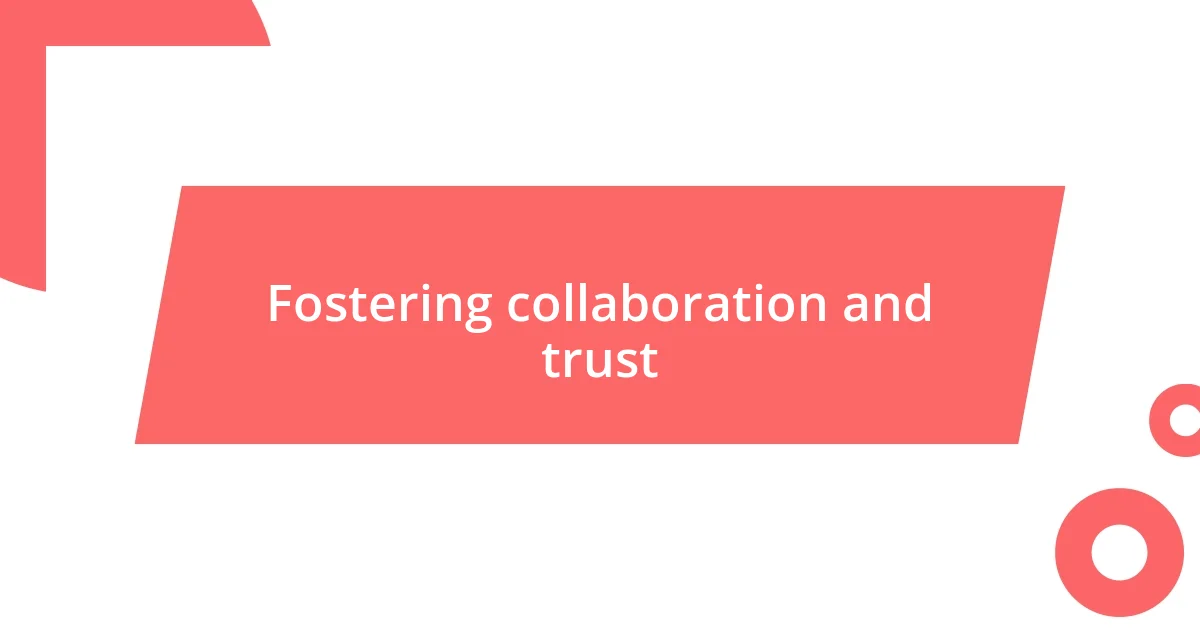
Fostering collaboration and trust
When building collaboration and trust within a team, I believe that transparency is key. I remember one project where I decided to share my own challenges openly with the team, admitting the stress and uncertainty I faced. This vulnerability not only allowed others to relate, but it also encouraged them to share their own struggles. Have you ever felt the weight lift when someone shows genuine honesty? That’s how trust begins to flourish.
Encouraging collaboration means recognizing and celebrating the unique strengths each member brings. I once made it a point to highlight the contributions of quieter team members during our meetings. For instance, I would say, “Let’s take a moment to consider what Jenna brings to this project.” This not only made Jenna feel valued but also inspired others to share their talents. Isn’t it amazing how a few kind words can spark empowerment and drive a team forward?
Building a foundation of trust takes time and effort. I learned this firsthand during a team retreat where we engaged in team-building exercises that challenged us to rely on one another. One activity involved blindfolded navigation through an obstacle course, where trust was built as each member guided their partner. The experience was eye-opening; it showed me that when trust is established, collaboration feels effortless. Have you ever participated in an activity that transformed the way you work with others? It’s those moments that solidify our bonds and invite us to innovate together.
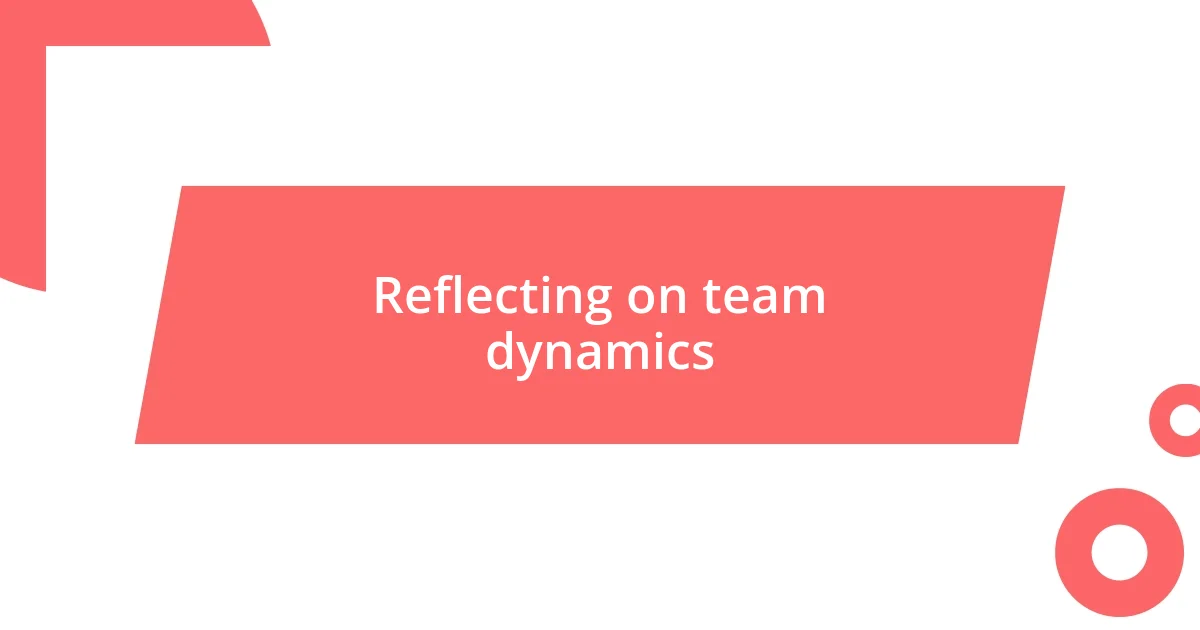
Reflecting on team dynamics
Reflecting on team dynamics often reveals the intricate layers of communication and collaboration at play. I can think of a time when I participated in a project where differing personalities led to tension among team members. Instead of brushing it aside, I initiated regular check-ins, creating a platform for everyone to express their thoughts, frustrations, and ideas. This not only cleared the air but deepened our understanding of each other’s working styles. Have you ever noticed how simply talking can transform an entire team’s energy?
I remember one project where I felt an imbalance in participation; some voices were much louder than others. To remedy this, I introduced a rotating moderator role during our meetings. This small change empowered quieter team members to take charge of discussions, fostering a richer dialogue and increased commitment. It was incredible to see how this shift not only diversified our perspectives but also created a sense of shared ownership among the team. Isn’t it remarkable how a strategic change can unlock hidden potential in a group?
Sometimes, reflecting on team dynamics involves acknowledging the emotional currents that run beneath the surface. I encountered a moment where a team member was visibly disengaged, impacting our group morale. Instead of ignoring it, I took the time to check in with them one-on-one. This simple act revealed that personal challenges were affecting their engagement, and we worked together to find solutions. It reminded me that empathy plays a crucial role in maintaining a healthy team environment. Haven’t you found that understanding one another can solidify trust and strengthen resolve?










